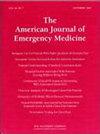Early crystalloid resuscitation in Trauma: How much is too much? Insights from a National Trauma Registry
IF 2.2
3区 医学
Q1 EMERGENCY MEDICINE
引用次数: 0
Abstract
Background
Crystalloid administration during early resuscitation of bleeding trauma patients is recommended by current guidelines, yet evidence supporting this practice is limited. We aimed to evaluate the trends in the utilization of crystalloids during the last decade and to determine the threshold crystalloid volume independently associated with mortality risk in trauma patients at risk of or experiencing shock.
Methods
A retrospective cohort study using data from the Israel National Trauma Registry (January 2013 to December 2022) was conducted. We included patients ≥16-years-old transported by emergency medical services from the injury scene and subsequently hospitalized. Inclusion criteria included systolic blood pressure < 90 mmHg and/or shock index >1 in the field or emergency department (ED). Patients transferred between facilities, those who received prehospital blood products, or those who suffered burns were excluded. The primary outcome was all-cause in-hospital mortality. Multivariable logistic regression was performed to investigate the association between the total volume of crystalloid administered during prehospital and ED treatment and the primary outcome, adjusting for clinical variables.
Results
Among 10,707 eligible patients, the median age was 39.0 years (IQR 25.0–65.0), 63.5 % were male, and 81.4 % suffered from blunt trauma, mainly caused by motor vehicle collisions. There was a trend toward reduced crystalloid use over the study period both prehospital and in the ED. Crystalloid volumes ≥2 liters were independently associated with increased mortality with an aOR of 1.47 (95 % CI 1.09–1.96, p = 0.01) for 2000–2499 ml and an aOR of 1.49 (95 % CI 1.08–2.04, p = 0.01) for ≥2500 ml. Older age, male gender, lower blood pressure, and severe injury (ISS >15) were also independently associated with higher mortality.
Conclusion
The administration of ≥2 liters of crystalloids during the initial phase of care was independently associated with increased mortality in hemodynamically compromised trauma patients. These findings support the judicious and goal-directed use of crystalloids in the resuscitation of trauma patients.
创伤中的早期晶体液复苏:多少才算多?来自全国创伤登记处的启示
背景目前的指南推荐在对出血的创伤患者进行早期复苏时使用晶体液,但支持这种做法的证据却很有限。我们旨在评估过去十年间晶体液的使用趋势,并确定与有休克风险或正在经历休克的创伤患者的死亡风险独立相关的晶体液阈值容量。方法 我们利用以色列国家创伤登记处(2013 年 1 月至 2022 年 12 月)的数据开展了一项回顾性队列研究。我们纳入了由紧急医疗服务从受伤现场转运并随后住院的年龄≥16 岁的患者。纳入标准包括现场或急诊科(ED)的收缩压< 90 mmHg和/或休克指数>1。不包括在不同医疗机构之间转院的患者、接受院前血液制品的患者或烧伤患者。主要结果是全因院内死亡率。结果10707名符合条件的患者中,中位年龄为39.0岁(IQR 25.0-65.0),63.5%为男性,81.4%为钝性创伤,主要由机动车碰撞引起。在研究期间,院前和急诊室的晶体液使用量呈下降趋势。晶体液容量≥2 升与死亡率增加有独立关联,2000-2499 毫升的 aOR 为 1.47(95 % CI 1.09-1.96,p = 0.01),≥2500 毫升的 aOR 为 1.49(95 % CI 1.08-2.04,p = 0.01)。年龄较大、性别为男性、血压较低和严重损伤(ISS >15)也与死亡率升高密切相关。这些研究结果支持在对创伤患者进行复苏时明智地、以目标为导向地使用晶体液。
本文章由计算机程序翻译,如有差异,请以英文原文为准。
求助全文
约1分钟内获得全文
求助全文
来源期刊
CiteScore
6.00
自引率
5.60%
发文量
730
审稿时长
42 days
期刊介绍:
A distinctive blend of practicality and scholarliness makes the American Journal of Emergency Medicine a key source for information on emergency medical care. Covering all activities concerned with emergency medicine, it is the journal to turn to for information to help increase the ability to understand, recognize and treat emergency conditions. Issues contain clinical articles, case reports, review articles, editorials, international notes, book reviews and more.

 求助内容:
求助内容: 应助结果提醒方式:
应助结果提醒方式:


